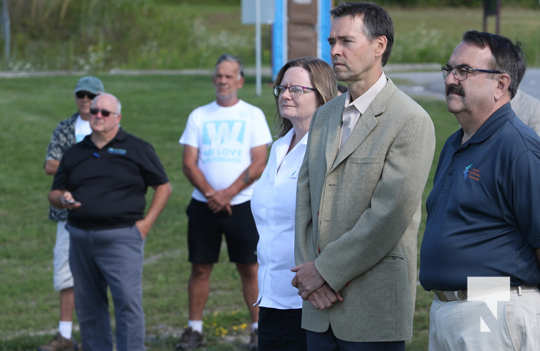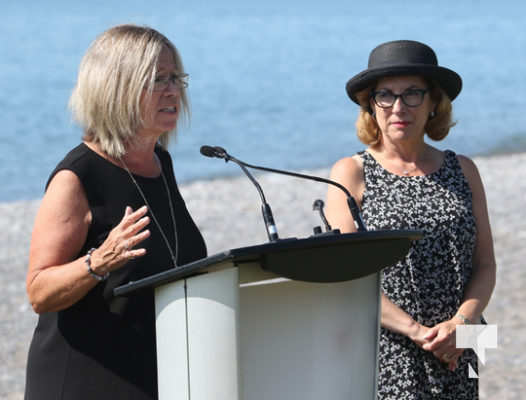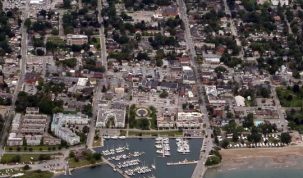For full interview with MP Kim Rudd click here
Will upload video of interview and will post as soon as possible.
Press Release
Flooding is Canada’s costliest and most frequent natural disaster. Communities are looking for solutions to mitigate the costs and damages caused by flooding to businesses and residences.
On Friday, August 23, 2019, Member of Parliament for Northumberland—Peterborough South, Kim Rudd, on behalf of the Minister of Public Safety and Emergency Preparedness, the Honourable Ralph Goodale, announced $150,000 in federal funding to the Province of Ontario to support updated flood mapping of the Lake Ontario shoreline under the National Disaster Mitigation Program (NDMP).
Additionally, Ganaraska Region Conservation Authority, Central Lake Ontario Conservation Authority, and Lower Trent Region Conservation Authority are each contributing $57,500, which is being funded by the benefitting municipalities, in support of this project, for a total project value of $322,500.
This funding is helping create a shoreline management plan through updated flood mapping and hazard assessment of the Lake Ontario shoreline, covering a 130kilometre reach from Ajax, Ontario to Brighton, Ontario. The resulting plan will recommend management practices to help prevent and/or mitigate the effects of Lake Ontario on the surrounding shoreline communities and guide future land-use decisions.
The Government of Canada cost-shares up to 50 per cent of eligible expenses for projects submitted by provinces and 75 per cent of eligible expenses for projects submitted by territories under the NDMP.
Since the launch of the NDMP in 2015, the Government of Canada has contributed almost $40 million under the program for 189 projects across the province.
Through the recently released Emergency Management Strategy for Canada, the Government of Canada is committed to working with provincial and territorial partners to better identify, plan for and reduce the impact of weather-related emergencies and natural disasters on Canadians.
Quotes
“This spring, Ontario residents witnessed first-hand how weather-related natural disasters are getting more severe, more frequent, more damaging and more expensive due to climate change. The Government of Canada is proud to work collaboratively with our partners to support proactive projects like the one announced today, which will help provide the tools to better protect the safety of our citizens and build safer and more resilient communities.”
Kim Rudd, Member of Parliament for Northumberland—Peterborough South, on behalf of the Honourable Ralph Goodale, Minister of Public Safety and Emergency Preparedness
“On behalf of the Central Lake Ontario Conservation Authority, the Lower Trent Region Conservation Authority and the Ganaraska Region Conservation Authority, I would like to express our appreciation to the federal government for the funding which has been approved for this very important project. The funding will allow the Authorities to identify and update Lake Ontario shoreline hazard mapping and to provide guidance to our member municipalities in making sound shoreline management decisions.”
Linda Laliberte, CAO/Security-Treasurer, Ganaraska Region Conservation Authority
Quick Facts • The NDMP reflects an investment of $200 million over five years, of which $183 million is available for cost-shared, merit-based projects with provinces and territories to reduce the impacts of natural disasters.
• Since the launch of the NDMP in 2015, the NDMP has approved funding for 363 projects across Canada that are helping to build safer, more resilient communities.
• Through the NDMP, the Government of Canada is helping to address rising flood risks and costs and build the foundation for informed investments that could reduce, or even negate, the effects of flood events.
• In addition to investing in provincial and territorial flood mitigation projects through the NDMP, the Government of Canada: o is investing in public awareness activities and risk and resiliency tools like the Federal Flood Mapping Guidelines, to help all levels of government to make informed decisions around flood mitigation; o has created a new $2 billion federal Disaster Mitigation and Adaptation Fund to support the infrastructure required to deal with the effects of a changing climate; and o is integrating climate resilience into the National Building Code and conducting research to factor climate resilience into the design of buildings.
• According to the Insurance Bureau of Canada, insured damage in 2016 topped $4.9 billion – passing the previous annual record of $3.2 billion set in 2013 – and the annual economic cost of disasters around the world has increased five-fold since the 1980’s. Flooding damage has accounted for 80 per cent of federal disaster assistance payments over the past 20 years.
• Studies have demonstrated that when structural and non-structural investments are implemented in concert, the result is 6:1 return on investment.

























